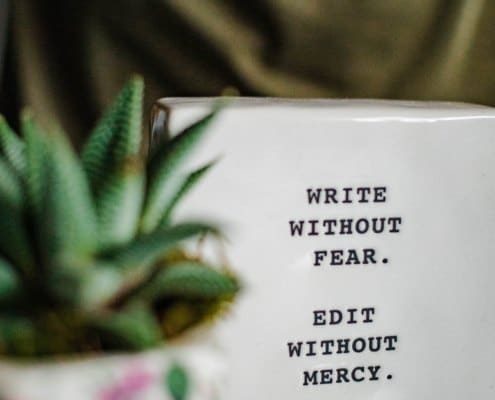What’s in an Edit?
Written by FriesenPress
Editing is when a red pen marks up everything wrong with your writing… Or is it? 
No, editing is a complex and nuanced craft that makes authors’ prose dazzle with professional polish, helping a manuscript become the best book it can be. But what exactly does an editor do to your book in order to get it into publishing shape?
Here we explore the finer points of the various types of editing and what each delivers. Ideally, different aspects of the manuscript will be addressed during separate rounds of editing, enabling a back-and-forth between the author and one or more editors.
Editor’s Manuscript Evaluation
Also called a manuscript assessment, an editor’s manuscript evaluation is usually a manuscript’s first step toward becoming a book. The editor reads through the full manuscript (sometimes multiple times), looking at the content with a critical eye. Does it convey the author’s intentions clearly? Is it appropriate for its intended audience? Are there areas that are underdeveloped, grammatical foibles that repeatedly crop up, or specific narrative choices that need some finessing?
The editor then collects their feedback in a report to articulate their findings. A well-considered evaluation includes:
- an overview to ensure the editor understands the project’s goals;
- aspects of the writing that are currently working well and should be preserved;
- suggestions for revisions using specific examples, explaining the impact on intended readers;
- and a recommendation for what kind of editing is best at this stage.
Each editor has a unique vision for how a book can be improved; does the evaluation’s approach resonate with you? If not, does it spark an idea for an alternate solution? Evaluations provide insight into where you can improve your craft and the marketability of your project. Some authors want brutal honesty; others need a gentle and reassuring approach. The best advice in the world won’t help if it’s not presented in a way you can absorb, so the evaluation gives a sense of the editor’s tone. Make sure you’re a good match!
If the recommendation is multiple rounds of editing, you should receive an explanation of what will be addressed at each stage. For example…
Developmental Editing
Also called structural editing, developmental editing is high-level holistic editing. (Holistic editing is when the editor considers the context of the work as a whole and how it serves its audience.) At this stage, there’s no point getting lost in the minutiae of commas and colons if your ideas still need to be organized. Therefore, the primary goal is to ensure what’s on the page is as effective as possible.
The editor keeps an eye on the flow of ideas. They create a table of contents (or other infrastructure) around which to group ideas or deliver salient plot points. They leave comments recommending a section be expanded, revised, or rewritten from another angle. In nonfiction, they might point out missing citations or weak arguments. In fiction, they might highlight plot holes, inconsistent characterization, or failing logic.
The goal is for you to review these suggestions and rewrite sections to solve the flagged problems. If a specific suggestion doesn’t work for you, think up an alternate solution. Maybe if you reveal that clue in chapter three, this mention in chapter six doesn’t need to change after all!
Revisions after a developmental edit are often significant — and mechanical editing has not yet happened — so it’s always a good idea to get a follow-up edit that will address technical issues. Such as…
Content Editing
Also called substantive editing, content editing has some overlap with a developmental edit. It’s also a holistic edit, but development is usually localized or doesn’t require domino-effect revisions. The editor still uses comments to point out inconsistencies and logical flaws, but these are usually changes the author can make at a paragraph or line level. Because of this, the editor can simultaneously work on the mechanical aspects of the edit.
Content editing can look like the “heaviest” edit: proposed segues or reordered paragraphs, adjustments to sustain voice, suggestions for word choice and connotation, revisions to grammar, spelling, number treatments, punctuation, and comments for places the author might add new content. Because of how comprehensive this type of editing is, it can be a one-stop edit. However, because of how in-depth it is and because it invites the author to make further changes, there’s a higher likelihood that there may be minor edits still required after the content edit is reviewed. So, it’s a good idea to get another review, such as…
Copy Editing
Also called copyediting or line editing, the copy edit should only be undertaken once all of the structural, content, and developmental work is completed. At this stage, the editor’s goal is to preserve the author’s voice while smoothing out tangled syntax and cleaning up grammatical errors. The copyeditor’s focus is on the “four Cs”: correctness, clarity, completeness, and conciseness.
Correctness means adhering to internal rules, such as whether you’ll be using the Oxford comma, how you’ll treat numbers, and what style guide and English convention (American versus British, for instance) your book will adhere to. A skilled editor knows when to let “incorrect” grammar stand when “fixing” it would negatively impact a reader’s expectations for genre, level of formality, or authorial voice. The best writers break the rules; the editor’s job is to ensure rules are broken in cohesive, effective ways.
Clarity means ensuring a turn of phrase, word choice, or lack or explanation doesn’t misconstrue your intention. The editor assesses the audience’s reading level, whether jargon is appropriate or alienating, and comprehension for when needed context is missing. Language is nuanced, so there may be more than one solution.
Completeness means that all the information necessary for the previous two points is present on the page. This includes making sure chapter numbering follows the correct sequence, that necessary citations are all present, and that no paragraphs or sentences were left unfinished.
Conciseness means being economical with words — while respecting the previous three points. The editor prunes repetition (at the line level), bloated phrasing, and filler or too-often-repeated words.
Because these sorts of changes are often fairly self-explanatory, an editor only leaves comments to confirm they understand the author’s meaning where it’s ambiguous, or to clarify a deeper change where it might not be readily apparent.
Copy editing is often the last stop for a manuscript’s editing journey. But if there are a high number of revisions, or if you’ll be adding images or having a designer create a printable layout, it’s always good to get a last review…
Proofreading
In the days of movable type, proofreading ensured all elements aligned properly, including text, graphics, and headings. These days, many proofreads are done digitally, so it’s unlikely an independent author will be working with the proofreader’s shorthand marks. You’ll likely receive track changes as in previous rounds, but proofreading is a different skillset.
All decisions for content, organization, grammar, voice, syntax, spelling, and punctuation should already have been decided in previous rounds of editing. These choices are typically recorded in a style sheet. This document includes your book’s dictionary, style guide, English convention, and any unique choices (like uncommon spellings of names, topical acronyms or terminology, and formatting choices). A proofreader’s job is to go through the full content to ensure everything adheres to the style sheet.
This can include:
- catching last minute typos,
- grammatical errors,
- accidental font changes,
- mismatched photo captions,
- incorrect cross-references,
- distracting spacing (between words, lines, or hyphenation),
- and design gaffs (widowed or orphaned sentences, missing content, header errors, or legibility issues).
For a proofreader to address design elements, they’ll need both a live version of the text (like a DOCX) and a fixed proof (like a PDF). Make sure your designer can easily implement your editor’s suggestions after your layout. Otherwise, your proofreading options may be limited.
Because this is the very last review before publication, it’s wise to get a fresh pair of eyes on your manuscript. Every editor has blind spots, so a fresh perspective may help catch details another editor missed.
As you can see, each type of editing addresses different needs. Multiple rounds provide an in-depth coaching experience to develop your writing craft for this and future books. Of course, a manuscript may not need every round. A thorough content edit may address your copy editing needs, enabling you to jump next to a proofread.
Whatever you decide, editing is like polishing marble — starting with the raw block of an idea, shaping it, carving it into its purest form, and finally polishing it to shining. With each round, you’ll gain deeper insight into your project and a greater appreciation of the attention to detail editors bring to each book on your shelf.
FriesenPress has helped thousands of authors self-publish their books with professional support. From editing and book design to distribution and book promotion, we help writers self-publish and succeed. Contact us at 1-800-792-5092 or download our free Author’s Guide to learn more!
